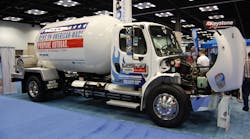As interest among fleets continues to build about switching to alternative fuels – including everything from hybrid to full-electric models, as well as ones fired by natural gas and propane – questions still linger as to whether such they have the legs to last long-term.
At the recent Green Truck Summit in Indianapolis – held in conjunction with the National Truck Equipment Association’s (NTEA) 2013 Work Truck Show – several industry experts noted that surmounting the many challenges a national switch to alternative fuels entails will require a level of political and public will that could be difficult to sustain.
“There’s a good deal of local availability when it comes to such alternative fuels as CNG [compressed natural gas], LNG [liquid natural gas], propane, and electricity – it’s when you look at embedding the infrastructure for them on a national basis that it gets real challenging,” George Survant, senior director of fleet management for Time Warner Cable, told Fleet Owner.
“If you look at the [alternative fuel] picture purely on the basis of infrastructure, then electricity wins out because we have electrical distribution on a national basis,” he explained. “But that distribution network is the direct result strategic federal policy undertaken in the 1930s to provide electricity to every single household – even the ones at ‘the far end of the lane’ and even if the power company didn’t want to.”
Providing a similar level of natural gas or propane infrastructure to support large swaths of the nation’s cars and commercial vehicles would take years and hundreds of billions worth of investment to accomplish, he cautioned – requiring a long-term commitment not only by policymakers but the general public as well.
“It’s not to say that we can’t do it – Americans have proven over history that we can accomplish such massive changes; just look at the country’s manufacturing ramp-up during World War II,” Survant said. “But it’s going to require a massive shift in our national policy and our culture to truly make a sustainable shift to alternative fuels.”
Doyle Sumrall, NTEA’s senior director of business development, opined that the next decade will be the time period when such a “trend change” to alternative fuels will – or will not – occur in the U.S.
“Right now, some of the key advantages are that the [alternative] fuel technology is more advanced and robust than before, plus we understand vehicle duty cycles better than we ever have before as well,” he told Fleet Owner. “The engineering evolution happening now where alternative fuels are concerned is creating a far greater order of magnitude in terms of how we can ‘tune’ trucks operating on such fuels like CNG to their expected duty cycle.”
Still, in a presentation at the Green Truck Summit, he stressed that the cost of bringing alternative fuel technology to the truck market remains high and is intensified by what he calls “instability and failures” in the supply chain. “Driver training and ‘buy-in’ is also critical to achieving full alternative fuel potential,” Sumrall added.
Both Survant and Sumrall pointed out that diesel can’t be counted out of the future fuel picture wither, with Sumrall noting that “diesel will be with us for a very long time and we can expect breakthroughs to continue with this technology.”
Indeed, Survant noted that no alternative fuel today can match the 130,000 BTU energy contend of diesel. “For example LNG is two-thirds of that on a good day,” he said. “That’s one reason why the jury is still out where most alternatives are concerned.”
Yet Survant also emphasized that one factor could make a big difference in the “sustainability” of alternative fuels especially in the commercial truck world: price volatility.
“It’s the issue of price volatility where gasoline and diesel are concerned,” he said. “Fleets can accommodate and manage even $4 per gallon [diesel] fuel if the price remains stable; it’s when it goes from $4 to $4.25 then to $4.15 and then to $4.30 that it becomes extremely difficult to deal with.”



